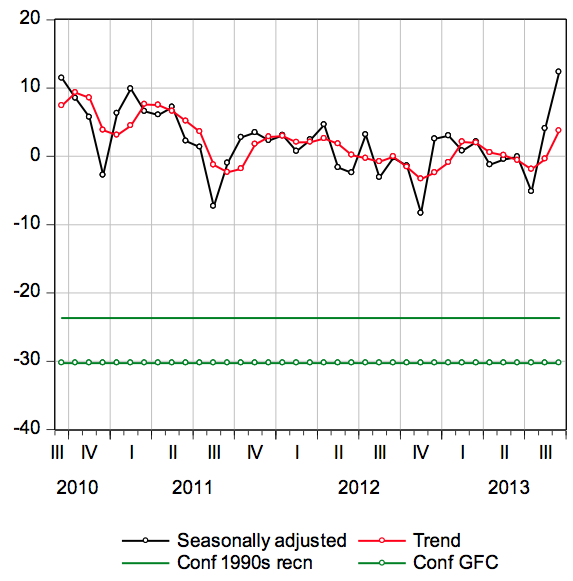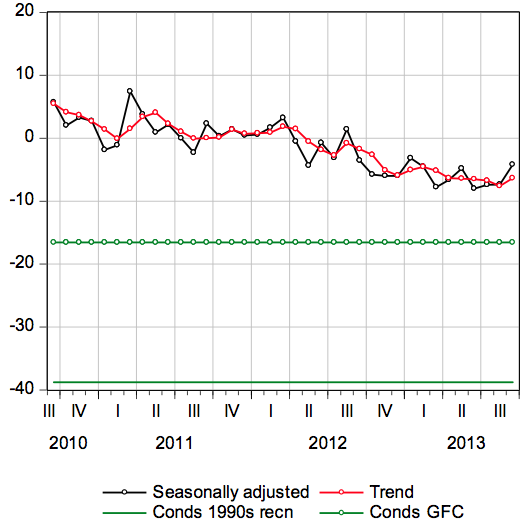As was expected, business confidence jumped sharply in the wake of the September 7 election result, but that has had little impact on the still sluggish conditions locally for companies.
And at the same time the monthly job ads survey from the ANZ Bank revealed a small improvement last month, but nothing really to get excited about.
The National Australia Bank’s monthly business survey revealed that corporate confidence rose to a three and a half-year high last month of 12 points, up from four in August and minus five in July.
It was the highest level since March 2010, when the RBA lifted its key cash rate and then repeated the increase in April as conditions seemingly normalised after the cooling of the GFC.
The RBA cut rates in August, which did provide a small boost to confidence in that month, and that impetus was added to by the election result.
Confidence gets another leg up

Source: NAB
Business conditions improved slightly to a reading of minus four last month from minus seven in August and July.
The news confirms other anecdotal evidence of an improvement in sentiment among business and consumers (which will show up later today in the Westpac survey of consumer sentiment) since the Abbott government won office in the Federal poll on September 7.
The news won’t have an impact on Reserve Bank thinking – in fact this was expected by the central bank as well.
The RBA will be looking more for an improvement in business conditions in coming months.
Conditions improve moderately

Source: NAB
The news had no impact on the Aussie dollar which remains well over 94 USc as markets start to fret about the US budget shutdown and debt ceiling brawl in Washington.
The NAB said the survey reported a positive reading in confidence across all industries, the first time an across-the-board lift has been seen in almost three years.
"Low borrowing rates, rising consumer sentiment and a lower dollar may have also helped – especially in recreation & personal services and retail. Also better news from China probably helped sentiment in mining," the NAB commented.
Business conditions across industries were mixed, however, with some sectors reporting strong improvements, while others such as transport and utilities fell.
"Business conditions, however, still subdued – with employment poor," NAB chief economist Alan Oster commented.
The finance, business, property and construction sectors reported big gains in conditions, possibly driven by the strengthening housing market, according to Mr Oster’s analysis.
But "activity remained worryingly weak in mining and manufacturing, while conditions in transport and utilities have recently turned down to very poor levels".
"Transport conditions have turned down sharply over recent months, a worrying development given that this industry is often viewed as a bellwether of future demand," Mr Oster said.
But business conditions lifted strongly in Western Australia, rising 20 points to 11 – their highest level since July 2012. They lifted by three points in South Australia, remained unchanged in Victoria and NSW, but slipped by one point in Queensland.
The sharp improvement in conditions in the west should have really had a more dramatic impact on mining given that state’s dominance of the sector.
But despite the mixed nature of the report, the NAB managed to find a bit of good news from the conditions reporting "Some hope for better activity to come, with orders, stocks and capacity utilisation rising to fresh highs for the year. Nonetheless, employment conditions remain subdued, painting a soft outlook for the labour market."
The ANZ job ads survey showed an 0.2% improvement in September, the first rise in seven months.
But the number of ads is still 15% under where they were a year ago and the ANZ said the rise was ‘technical‘ and the end result was no change.
"Newspaper job advertisements rose 1.1% m/m in September, a relatively sharper increase than internet job advertisements which rose 0.2% m/m in the month.
"However, because newspaper job ads make up less than 5% of overall job ads, this did not significantly impact the overall outcome for September," the ANZ said.
But at least there was not another fall, as there had been since March.
"Trends in job advertising appear to be stabilising," said Ivan Colhoun, ANZ’s chief economist for Australia in yesterday’s release.
"Along with a number of other leading indicators of the labour market, the rate of deterioration in ANZ job ads has moderated in recent months, with job advertising showing signs of improvement in a number of states and territories."
Mr Colhoun said while he expected unemployment to drift modestly higher, the worst of the rise in the jobs market looks likely to have past.
"The stabilisation in job advertising in September is consistent with other indicators of an improvement in consumer and business confidence in the weeks leading up to and immediately following the September federal election," Mr Colhoun added.
"It will be important for these trends to be sustained in the months ahead."
The more important September jobs report from the Bureau of Statistics will be issued tomorrow.













